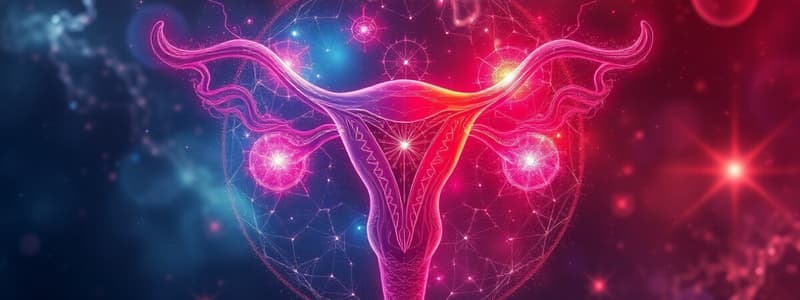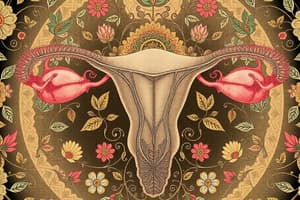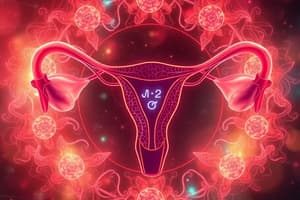Podcast
Questions and Answers
What role does dihydrotestosterone (DHT) primarily play in the body?
What role does dihydrotestosterone (DHT) primarily play in the body?
- Promotes the formation of gonads during embryogenesis (correct)
- Stimulates spermatogenesis in the testes
- Influences sex drive in the brain
- Regulates the menstrual cycle in females
Which of the following statements about the menstrual cycle is incorrect?
Which of the following statements about the menstrual cycle is incorrect?
- Ovulation typically occurs on day 14 of the cycle
- The average duration of menses is between 2-7 days
- The normal menstrual cycle has a range of 21-35 days
- The mean duration of the menstrual cycle is 28 days for all women (correct)
What primarily drives the cyclic changes in hormone levels throughout the menstrual cycle?
What primarily drives the cyclic changes in hormone levels throughout the menstrual cycle?
- Local changes in the endometrium
- Estrogens and progesterone only
- Paracrine signaling within the ovaries
- Hypothalamic-pituitary-gonads axis regulation (correct)
Which phase of the menstrual cycle is characterized by the thickening of the endometrium?
Which phase of the menstrual cycle is characterized by the thickening of the endometrium?
At what age does female puberty typically begin?
At what age does female puberty typically begin?
What major event marks the end of the follicular phase?
What major event marks the end of the follicular phase?
Which statement accurately describes the role of FSH during the follicular phase?
Which statement accurately describes the role of FSH during the follicular phase?
What feedback mechanism is observed when estrogen levels rise during the preovulatory period?
What feedback mechanism is observed when estrogen levels rise during the preovulatory period?
During the luteal phase, which hormone primarily supports the development of the uterine lining?
During the luteal phase, which hormone primarily supports the development of the uterine lining?
What happens to the corpus luteum if pregnancy does not occur?
What happens to the corpus luteum if pregnancy does not occur?
Which role does hCG play during early pregnancy?
Which role does hCG play during early pregnancy?
What physiological change is primarily responsible for the onset of menstruation?
What physiological change is primarily responsible for the onset of menstruation?
Which of the following processes occurs during the recruitment stage of the follicular phase?
Which of the following processes occurs during the recruitment stage of the follicular phase?
What happens when GnRH is administered continuously?
What happens when GnRH is administered continuously?
Which of the following hormones is primarily responsible for stimulating spermatogenesis?
Which of the following hormones is primarily responsible for stimulating spermatogenesis?
How does high estrogen levels affect LH secretion?
How does high estrogen levels affect LH secretion?
What role do aromatase enzymes play in female sex hormone biosynthesis?
What role do aromatase enzymes play in female sex hormone biosynthesis?
During male puberty, which of the following is NOT a characteristic change?
During male puberty, which of the following is NOT a characteristic change?
Which cells are primarily responsible for the production of estrogen in females?
Which cells are primarily responsible for the production of estrogen in females?
What effect does progesterone typically have on GnRH secretion?
What effect does progesterone typically have on GnRH secretion?
What initiates the process of puberty?
What initiates the process of puberty?
Which hormone negatively regulates GnRH secretion?
Which hormone negatively regulates GnRH secretion?
What is a key role of luteinizing hormone (LH) in males?
What is a key role of luteinizing hormone (LH) in males?
Flashcards
Spermatogenesis
Spermatogenesis
The process by which sperm cells are produced in the testes. Requires both follicle stimulating hormone (FSH) and testosterone.
Testosterone
Testosterone
The male sex hormone that stimulates the development of secondary sex characteristics, influences sexual drive and plays a role in sperm production.
Hypothalamic-pituitary-gonadal axis
Hypothalamic-pituitary-gonadal axis
The main regulatory axis for sex hormone production. It involves the interaction of the hypothalamus, pituitary gland, and gonads.
Ovulation
Ovulation
Signup and view all the flashcards
Luteal phase
Luteal phase
Signup and view all the flashcards
Follicular Phase
Follicular Phase
Signup and view all the flashcards
Recruitment
Recruitment
Signup and view all the flashcards
Maturation of the Follicle
Maturation of the Follicle
Signup and view all the flashcards
Selection
Selection
Signup and view all the flashcards
Preovulatory Period
Preovulatory Period
Signup and view all the flashcards
LH Surge
LH Surge
Signup and view all the flashcards
hCG (Human Chorionic Gonadotropin)
hCG (Human Chorionic Gonadotropin)
Signup and view all the flashcards
Menstruation
Menstruation
Signup and view all the flashcards
GnRH (Gonadotropin Releasing Hormone)
GnRH (Gonadotropin Releasing Hormone)
Signup and view all the flashcards
Gonadotropins (FSH & LH):
Gonadotropins (FSH & LH):
Signup and view all the flashcards
Two-Cell System in Males (LH & FSH)
Two-Cell System in Males (LH & FSH)
Signup and view all the flashcards
Two-Cell System in Females (LH & FSH)
Two-Cell System in Females (LH & FSH)
Signup and view all the flashcards
Testosterone Negative Feedback
Testosterone Negative Feedback
Signup and view all the flashcards
Estrogen Feedback
Estrogen Feedback
Signup and view all the flashcards
Puberty
Puberty
Signup and view all the flashcards
Male Puberty
Male Puberty
Signup and view all the flashcards
Male Secondary Sexual Characteristics
Male Secondary Sexual Characteristics
Signup and view all the flashcards
Study Notes
Sex Hormones
- GnRH (Gonadotropin-Releasing Hormone) is the initial step in sex hormone production.
- GnRH is released in a pulsatile manner from the hypothalamus.
- GnRH pulse rate impacts subsequent FSH/LH release patterns.
- Continuous GnRH administration decreases FSH/LH release.
Pituitary Factors: Gonadotropins
- The anterior pituitary responds to GnRH by releasing gonadotropins.
- FSH (Follicular Stimulating Hormone) is a gonadotropin.
- LH (Luteinizing Hormone) is a gonadotropin.
- FSH and LH's effects differ in males and females, though both utilize a two-cell system.
Males
- LH stimulates Leydig cells, leading to testosterone synthesis.
- FSH stimulates Sertoli cells, aiding in spermatogenesis.
- Testosterone directly promotes spermatogenesis.
Females
- LH stimulates Theca cells, enabling androgen synthesis.
- FSH stimulates Granulosa cells.
- Aromatase activation converts androgens to estrogens.
- Estrogen is produced from androgen precursors.
- Progesterone is a precursor to androgens.
- Both theca and granulosa cells produce estrogen under LH influence.
- The menstrual cycle is a continuous, cyclic process in females.
Female Reproductive Cycle
- The female reproductive cycle involves follicular maturation, ovulation, and corpus luteum formation.
- Follicles mature into primary, secondary, mature stages.
Ovarian Phases of Cycle
- Follicular Phase.
- Recruitment and maturation of ovarian follicles occur.
- FSH prompts follicular development.
- Typically only one follicle reaches maturity.
- Ovulatory Phase.
- Follicular growth and maturation conclude in ovulation.
- LH surge is a key trigger.
- Luteal Phase.
- The empty follicle transforms into a corpus luteum.
- Progesterone is produced.
- Menstruation occurs if no fertilization.
Biosynthesis of Sex Hormones
- The biosynthesis of sex hormones involves enzymatic conversions starting with cholesterol.
- Key enzymes are CYP11A1, 3βHSD, 17α-hydroxylase, and others.
- Specific pathways lead to testosterone, estrogens, and other hormones.
Negative Feedback
- Testosterone inhibits hypothalamic GnRH and pituitary FSH/LH secretion.
- High estrogen and progesterone levels can increase LH, with high estrogen increasing hormone effects.
- Progesterone alone diminishes GnRH pulse rate and anterior pituitary responsiveness to GnRH.
Puberty
- Puberty is initiated by hormonal signals from the brain to the gonads via the Hypothalamic-Pituitary-Gonadal (HPG) axis.
- The hypothalamus becomes less sensitive to gonadal steroids during puberty.
- Puberty is not a single event but a process spanning years.
Male Puberty
- Male puberty begins between ages 11-12.
- It generally ends between ages 16-17.
- It is characterized by androgen secretion (e.g., testosterone).
Androgens
- Testosterone is the primary androgen.
- Other androgens include androstenedione and dihydrotestosterone (DHT).
- Androgens are precursors to estrogens.
Actions of Androgens
- Testosterone stimulates spermatogenesis (sperm production).
- Testosterone promotes development of secondary sexual characteristics in males.
Male Secondary Sexual Characteristics
- Height and weight increase.
- Shoulders broaden.
- Muscle development improves.
- Sexual organs grow.
- Pubic and facial hair growth.
- Voice deepens.
- Body odor and acne increase.
Hypothalamic-Pituitary-Gonadal (HPG) Axis (Males)
- LH stimulates testosterone production by interstitial cells in the testes.
- Testosterone promotes secondary sex characteristics and spermatogenesis.
- Testosterone produces sex drive in the brain.
Hypothalamic-Pituitary-Gonadal (HPG) Axis (General).
- GnRH (Gonadotropin-Releasing Hormone) released by the hypothalamus, regulates the release of LH and FSH from the anterior pituitary.
- LH or FSH stimulate the gonads (testes or ovaries).
- The gonads release sex steroids (e.g., testosterone, estrogen).
- These hormones regulate secondary sexual characteristics, growth and other functions.
Dihydrotestosterone (DHT)
- DHT is a potent androgen converted locally from testosterone.
- DHT plays a role in male embryogenesis and gonadal formation.
- DHT leads to hair follicle development.
- DHT is implicated in androgenetic alopecia (male pattern baldness).
- Oestradiol plays a role in brain regulation of sexual drive, and in the development and maintenance of genitalia.
hCG (Human Chorionic Gonadotropin)
- hCG is initially secreted by the developing trophoblast.
- Acts like LH and FSH but not inhibited by progesterone.
- hCG maintains the corpus luteum in early pregnancy.
- Supports continued pregnancy.
Menstruation
- If no embryo develops, the corpus luteum deteriorates.
- Progesterone levels decrease.
- The uterine lining detaches, leading to menstruation.
- Blood and unfertilized egg are discharged.
- Menstruation typically lasts 3-7 days.
Menstruation Cycle (Hallmarks)
- The menstrual cycle is marked by periodic endometrial shedding (desquamation).
- Prostaglandins (hormones) peak just before menstruation, causing arteriole constriction and ischemia.
- This process is followed by arteriolar relaxation, leading to bleeding and tissue breakdown.
Follicular Phase (Recruitment, Maturation, Selection)
- FSH stimulates a cohort of ovarian follicles' maturation.
- Only one follicle matures fully.
- Estrogen plays a negative feedback role.
- The least successful follicles undergo atresia (breakdown).
Preovulatory Period (Negative & Positive Feedback)
- Estrogen (estradiol) exerts negative feedback on pituitary FSH release.
- Rising estrogen concentration triggers positive feedback, stimulating LH surge.
- LH surge initiates ovulation.
Preovulatory Period (LH Surge)
- LH surge lasts for approximately 48 hours, culminating in ovulation at about 36 hours.
- Rapidly falling estrogen levels accompany the surge.
- Granulosa cells transform into luteal cells, causing progesterone synthesis.
- The follicular wall ruptures, releasing the oocyte.
Luteal Phase
- The remaining follicle becomes the corpus luteum.
- The corpus luteum produces estrogen and progesterone.
- Progesterone prepares the uterine lining for pregnancy.
- If fertilization occurs, hCG maintains the corpus luteum.
Oral Contraceptives
- Combined oral contraceptives (COCs) contain estrogen and progesterone.
- Progesterone-only pills (POPs) are another option for contraception.
- These medications inhibit GnRH release, preventing FSH and LH surges thereby blocking ovulation.
- Both COCs and POPs are highly effective methods of contraception when used correctly.
Mechanism of Action (Oral Contraceptives)
- Estrogen and progesterone prevent GnRH, FSH and LH, preventing ovulation.
- The lack of ovulation prevents fertilization from occurring.
Pregnancy Tests
-
hCG (human chorionic gonadotropin) is a key indicator for pregnancy.
-
hCG is a hormone produced by the placenta during pregnancy.
-
hCG levels increase rapidly after conception and peak in the 8-11 weeks of pregnancy;
-
The hormone's presence can be detected in urine using pregnancy tests.
Studying That Suits You
Use AI to generate personalized quizzes and flashcards to suit your learning preferences.



